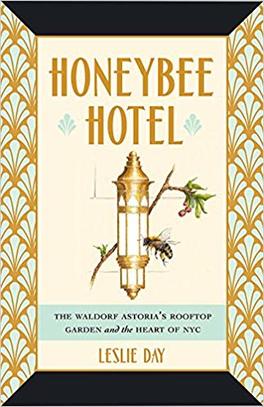Parable of the Bees: Leslie Day's Honeybee Hotel
Reviewed by Rebecca Dalzell
In 2012, the Waldorf-Astoria built six beehives in a rooftop garden. Twenty stories above Park Avenue, 300,000 bees pollinated flowering apple and cherry trees, and produced jugs of honey. Its flavor depended on the season: in the spring, it was light and minty; come fall, it darkened as bees foraged on aster and goldenrod. This miel de Manhattan made its way into cocktails, bread, and gelato served in the hotel restaurants.
It was brilliant PR for the locavore era. Yet in Honeybee Hotel: The Waldorf Astoria’s Rooftop Garden and the Heart of NYC, Leslie Day shows that this was no mere marketing stunt. David Garcelon, the Waldorf’s culinary director, had long valued seasonal produce and had previously cultivated a rooftop garden, with beehives, at a Toronto hotel. After New York lifted a ban on beekeeping in 2010, Garcelon proposed hives for the Waldorf and brought in expert beekeeper Andrew Coté. The bees arrived on a spring day in a Mercedes limo; chefs carried them through the art deco lobby, trailed by photographers. As the garden grew, cooks went up to pick zucchini blossoms, black plum tomatoes, or tarragon, and incorporated the honey into recipes that Day includes at the end of the book.
It’s a great story until you realize the dispiriting coda: The Waldorf is now owned by China’s Anbang Insurance Group (recently seized by the Chinese government) and closed for major renovations in 2017. The hives are long gone and the bees have moved to the Hilton on Sixth Avenue.
Imagine how Day felt when she read the news while finishing her manuscript. Perhaps that explains why the book feels unfocused. It hopscotches between the history of the Waldorf, going back to John Jacob Astor; chapters on the life of the male and female honeybee; and the story of the chefs involved, including Day’s nephew, Peter Betz, who worked under Garcelon. Day also brings in the Waldorf’s relationship with St. Bartholemew’s Church, across the street. The chefs donated leftover food and rooftop produce to its shelter, and on the day after Thanksgiving cooked an elaborate feast that seated paying guests beside the homeless. Though each component makes an interesting story, they don’t quite fit together into a coherent narrative.
Day, a naturalist who teaches at the New York Botanical Garden, is most at home writing about the bees. She makes you see the city from their perspective. We think of Manhattan as steel and concrete; bees find its many terraces, window boxes, and sidewalk saplings. They feast on the nectar of silver lindens and might fly a mile from the Waldorf to forage on flowers in Central Park. In the fall, they collect resin from street trees to make a caulk that fills holes in the hives. They chew off bits of amber from tree bark, carry it back to the hives, and mix it with saliva to make propolis, or bee glue, that seals cracks and protects them from the cold. The queen bee runs the place, constantly replenishing the hive by laying over 100,000 eggs a year. When the old queen dies, competitors vie to replace her, stinging each other to the death. Day reveals a parallel city with its own complex mechanics, production, and hierarchy.
Urban historians won’t learn as much about the hotel itself. Day only touches on the original Waldorf at 33rd Street and Fifth Avenue, which also had a rooftop garden. Guests could listen to music and drink lemonade, surrounded by palms, ferns, and flowering plants. It must have attracted bees, though there weren’t any hives we know about. While Day discusses early beekeepers, she doesn’t cover any in New York City. She mentions the early 20th-century rooftop farm at the Ansonia, but leaves us to wonder whether other buildings, or even the Waldorf, grew their own produce. The hotel must have sourced vegetables from the area — its maître d, Oscar Tschirky, ran a farm upstate — but we don’t find out. These would have been natural avenues to explore.
Such omissions might seem minor if it weren’t for the many tangential tidbits that Day does include, like how John Jacob Astor made his fortune and the creation of the Astor Library. There’s more about the fur trade than the original Waldorf rooftop. We learn, for instance, about Jasper National Park (where Garcelon once worked) and the requirements it met to become a UNESCO World Heritage site. These distracting asides make the book feel padded.
Day draws parallels between the industrious bees and the buzzing city around them. So, it’s fitting that the hives fell victim to a real estate deal. Good intentions, positive publicity, and tree resin couldn’t protect them from a shady conglomerate. New York, like nature, is cruel.
Rebecca Dalzell is a freelance writer and researcher, specializing in urban design, travel, and New York City history.
